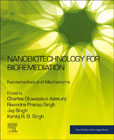
Nanobiotechnology for Bioremediation: Fundamentals and Mechanisms
Adetunji, Charles Oluwaseun
Pratap Singh, Ravindra
Singh, Ajay
RB Singh, Kshitij
Nanomaterials are effective in combatting pollution challenges. Nanobiotechnology for Bioremediation: Fundamentals and Mechanisms provides detailed information on nanomaterial application for the bioremediation of a heavily contaminated environment.Relevant information has been provided on the application of nanofibers, nanoscale zero-valent iron (nZVI), nanocomposites, carbon nanotubes for rejuvenation of a heavy environment from different pollutants, such as heavy metals, chlorinated compounds, organic compounds, polyaromatic hydrocarbon, and hydrocarbons. The book explores the application of nanomaterials, as a sustainable green solution, which help to prevent various high levels of contamination in the environment. Each chapter addresses the application of nanomaterials as a sustainable tool for managing innumerable environmental challenges. This helps readers to translate their research findings into sustainable innovations to resolve their immediate environmental challenges. Provides information on nanomaterial utilization for bioremediation of heavily polluted soil and water with pesticides and heavy metals Outlines the novel nanomaterial that could serve as adsorbents, especially in the management of heavy metal-polluted wastewater Explores the application of nanomaterial derived from microorganisms via immobilizing or through novel remediating microbial enzymes INDICE: 1. Introduction: Utility of Nanobiotechnology for Bioremediation 2. Nanofibers utility for rejuvenation of heavily contaminated environment3. Nanoscale zero-valent iron (nZVI) for rejuvenation of heavily contaminated environment4. Bionanocomposites for rejuvenation of heavily contaminated environment5. Biological carbon nanotubes for rejuvenation of heavily contaminated environment6. Utility of Biogenic nanomaterials for rejuvenation of heavy metals7. Novel nanomaterials via microorganisms for bioremediation8. Smart and Intelligent bionanomaterials as adsorbents for management of heavy metal-polluted wastewater9. Potentialities of Biogenic nanomaterial for bioremediation of soil and water with pesticides10. Bioremediation of chlorinated compounds 11. Bioremediation of organic compounds12. Bioremediation of polyaromatic hydrocarbon13. Mode of the mechanism of biogenic nanomaterials involved in the adsorption of pollutants
- ISBN: 978-0-323-91767-4
- Editorial: Elsevier Science
- Encuadernacion: Rústica
- Páginas: 660
- Fecha Publicación: 01/04/2023
- Nº Volúmenes: 1
- Idioma: Inglés
